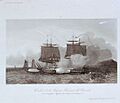HMS Minerva (1759) facts for kids

Minerva recaptures Warwick in 1761
|
|
Quick facts for kids History |
|
|---|---|
| Name | HMS Minerva |
| Ordered | 25 May 1756 |
| Builder | John Quallet, Rotherhithe |
| Laid down | 1 June 1756 |
| Launched | 17 January 1759 |
| Completed | 3 March 1759 at Deptford Dockyard |
| Commissioned | January 1759 |
| Fate | Captured by France, 22 August 1778 |
| Name | Minerve |
| Acquired | by capture, 22 August 1778 |
| Fate | Recaptured by Great Britain, 4 January 1781 |
| Name | HMS Recovery |
| Commissioned | January 1781 |
| Decommissioned | 1783 |
| Fate | Sold to break up at Deptford, 30 December 1784 |
| General characteristics | |
| Class and type | Southampton-class fifth-rate frigate |
| Tons burthen | 664 24⁄94 bm |
| Length |
|
| Beam | 34 ft 11.5 in (10.655 m) |
| Depth of hold | 12 ft 0 in (3.66 m) |
| Sail plan | Full-rigged ship |
| Complement | 210 officers and men |
| Armament |
|
HMS Minerva was a 32-gun frigate, a type of fast warship, built for the Royal Navy in 1759. She was one of four ships in her class. Minerva served during the Seven Years' War. Later, in 1778, during the American Revolutionary War, she was captured by the French.
The French renamed her Minerve. However, she was recaptured by the British in 1781 and then renamed HMS Recovery. The ship was eventually taken apart in 1784.
Contents
Minerva's Journey: A British Warship's Story
Building and Early Service
Minerva was built in Rotherhithe, England, between 1756 and 1759. She joined the Royal Navy as HMS Minerva during the Seven Years' War. Her first commander was Captain Alexander Hood.
In November 1759, Minerva took part in a big naval battle called the Battle of Quiberon Bay. This battle was an important victory for the British.
Capturing the Warwick
On January 24, 1761, Captain Hood and Minerva spotted a large French ship near Spain. Minerva chased the ship and caught up with it. After a quick fight, the French ship lost its main and fore top-masts.
Minerva also suffered damage, losing her bowsprit and fore-mast. Both ships had to stop fighting to clear the broken parts. Minerva was ready first and attacked again, forcing the French ship to surrender.
The captured ship was the French Warwick. It used to be a British ship, HMS Warwick, but the French had captured it in 1756. The Warwick was carrying supplies and soldiers to the Isle de France (now Mauritius). Both ships had many sailors killed or wounded in the battle.
Service in the American Revolutionary War
During the American Revolutionary War, Minerva was part of the British fleet in the West Indies. On August 14, 1778, she captured an American schooner named Fanny near Hispaniola. The Fanny was carrying timber from Connecticut.
Minerva's Capture by France
On August 22, 1778, Minerva, commanded by Captain John Stott, met a French frigate called Concorde. The British did not know that France had declared war on Britain. Captain Stott thought Concorde was a harmless trading ship and approached her.
However, Concorde fired at Minerva without warning. The British were surprised. An explosion on Minerva's deck damaged guns and injured many sailors. Captain Stott was badly hurt. After two and a half hours, Minerva had to surrender. Her masts were damaged, her steering wheel was destroyed, and her captain and first officer were out of action.
French Service and Recapture
After being captured, the ship was added to the French Navy and renamed Minerve. She was commanded by Nicolas Henri de Grimouard. However, her time with the French was short. On January 4, 1781, two large British warships, HMS Courageux and Valiant, recaptured her.
Final British Career
The Royal Navy took the ship back, but they renamed her HMS Recovery. This was because another ship named HMS Minerva had already been built to replace the lost frigate. HMS Recovery was put out of service in 1783 and sold to be broken up in 1784.
Images for kids



